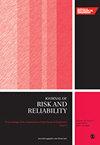Ant colony optimisation of a community pharmacy dispensing process using Coloured Petri-Net simulation and UK pharmacy in-field data
IF 1.7
4区 工程技术
Q3 ENGINEERING, INDUSTRIAL
Proceedings of the Institution of Mechanical Engineers Part O-Journal of Risk and Reliability
Pub Date : 2022-11-27
DOI:10.1177/1748006x221135459
引用次数: 0
Abstract
There are 11,619 community pharmacies in England which dispense over 1 billion prescriptions each year, providing essential primary care to NHS (National Health Service) patients. These pharmacies are facing pressure from a number of sources including funding cuts and high demands on services, while trying to deliver the highest standards of care. This paper presents an optimisation of a Coloured Petri Net (CPN) community pharmacy simulation model using an Ant Colony Optimisation (ACO) method. The CPN method was proposed by Naybour et al . Quantitative data from UK community pharmacies was collected by the authors and incorporated into the CPN simulation model. The optimisation is made up of a choice of how many staff to employ, which prescription checking strategy to use, and which staff work pattern to implement. This method aims to provide decision makers with a set of optimal pharmacy configurations at different cost levels. This can help to support pharmacy safety, efficiency, and improve decision making processes. It has been demonstrated how reliability modelling techniques traditionally used in safety-critical industries, can be used to carry out safety and efficiency analyses of healthcare systems, such as dispensing processes in community pharmacies, illustrated in this contribution.使用彩色Petri-Net模拟和英国药房现场数据的社区药房配药过程的蚁群优化
英格兰有11,619家社区药房,每年开出超过10亿张处方,为国民保健服务(NHS)患者提供基本的初级保健。这些药店在努力提供最高标准的医疗服务的同时,面临着来自许多方面的压力,包括资金削减和对服务的高要求。本文采用蚁群优化(ACO)方法对有色Petri网(CPN)社区药房仿真模型进行了优化。CPN方法由Naybour等人提出。作者收集了英国社区药房的定量数据,并将其纳入CPN模拟模型。优化由选择雇用多少员工、使用哪种处方检查策略以及实现哪种员工工作模式组成。该方法旨在为决策者提供一套不同成本水平下的最优药房配置。这有助于支持药房的安全性、效率和改进决策过程。它已经证明了传统上用于安全关键行业的可靠性建模技术如何可用于执行医疗保健系统的安全性和效率分析,例如社区药房的配药过程,这一贡献说明了这一点。
本文章由计算机程序翻译,如有差异,请以英文原文为准。
求助全文
约1分钟内获得全文
求助全文
来源期刊

Proceedings of the Institution of Mechanical Engineers Part O-Journal of Risk and Reliability
ENGINEERING, MULTIDISCIPLINARY-ENGINEERING, INDUSTRIAL
CiteScore
4.50
自引率
19.00%
发文量
81
审稿时长
6-12 weeks
期刊介绍:
The Journal of Risk and Reliability is for researchers and practitioners who are involved in the field of risk analysis and reliability engineering. The remit of the Journal covers concepts, theories, principles, approaches, methods and models for the proper understanding, assessment, characterisation and management of the risk and reliability of engineering systems. The journal welcomes papers which are based on mathematical and probabilistic analysis, simulation and/or optimisation, as well as works highlighting conceptual and managerial issues. Papers that provide perspectives on current practices and methods, and how to improve these, are also welcome
 求助内容:
求助内容: 应助结果提醒方式:
应助结果提醒方式:


